
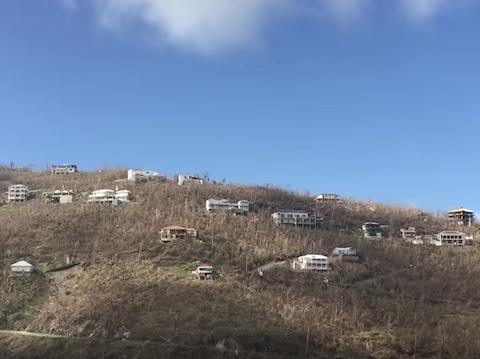
The hills of St. John, and St. John is nothing but hills, are green again. The bushes and vines and trees have generated new leaves.
The winds of Hurricane Irma demolished much of the island’s vegetation and structures on September 6. A photo from the NY Times on September 15, on the left, shows part of Cruz Bay, the main town on the island A still image from aerial footage posted on Youtube by Jon Adams on September 18, on the right, shows a hill above Coral Bay, a smaller town on the east end. Both images show brown, leafless hillsides. Soon afterwards, on September 20, Hurricane Maria dropped heavy rains on the island, compounding the destruction and misery.

|

|
Now, four and a half months later, life is struggling back. The roads have been cleared. All the beaches are open, and uncrowded. The hiking paths, except for the board walk on the Francis Bay Trail, are ready for hikers. The island looks green! Donkeys, goats, iguanas, anole & gecko lizards, soldier crabs, mongooses, and free-range chickens wander around. Most restaurants are open. Markets, shops, and both gas stations are open. Cottages are available for rent as are jeeps and other cars.
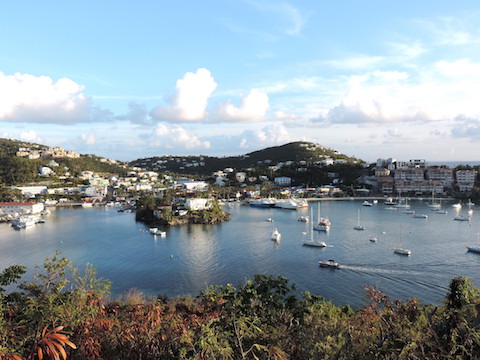
|
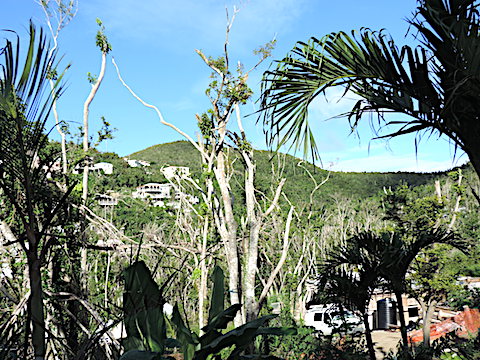
|
We arrived on St. John on Tuesday, January 23, after not visiting St. John since 2012. We had stopped coming because the campground where we stayed during our visits had closed. But St. John has many bays with miles of fringing reefs, ideal for snorkeling, so that it is hard to stay away. So we booked a cottage, rented a car, flew to St. Thomas, took the ferry from Red Hook, and were back on the beautiful island.
We had wanted to help with the recovery effort as well as have fun by volunteering with Friends of the Virgin Islands National Park. We even brought our work gloves with us. On Wednesday morning, we visited the park office to learn how to join the effort, but we learned there that they only had staff available to supervise volunteers on Wednesdays and that day’s crew had already departed.
|
The white sand beaches were not crowded. We often arrived in the mornings
to find the whole beach was ours, or shared with only one or two other
people.
We snorkeled seven times, every full day we were on the island, at five different bays and for one to two hours each time. At each reef we found the usual suspects: grunts, sargeant majors, bar jacks, snappers, trunkfish, goatfish, butterflyfish, beaugregories, yellowtail damselfish, gobies, blueheads, parrotfish, blue tangs, ocean surgeons, trumpetfish, and more. Sometimes we saw sand divers, porcupinefish, rays, barracuda, sea turtles, and squid, as well as fish we haven’t identified yet. At Salt Pond Bay we saw conch and crabs inhabiting conch shells. There were plenty of sea fans and sea rods. It seemed to me that we saw more juvenile fish on the reefs than in the past, along with a few fish large enough for a meal. I noticed many more squirrelfish than when we visited in the past. Either there were more of them or they were more willing to come out of hiding. We saw invasive Lionfish twice, once at Trunk Bay and once at Haulover Bay. When we went to town, we reported them at the park’s visitor center. We brought bad weather with us. Our flight arrived in a rain shower. During most of our swims, the sky was at least partially, if not completely, cloudy. In addition, there was a swell from the northeast that stirred up silt for the north shore bays and made the water murky. The day before we left, the clouds eased up and the wind died down, too late for us to get good underwater photos. |
| Three small squid at a mooring in Trunk Bay | One spots me and switches to a lighter color | All three squid now feel better camouflaged |
|---|---|---|
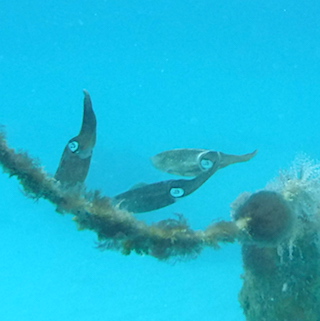
|
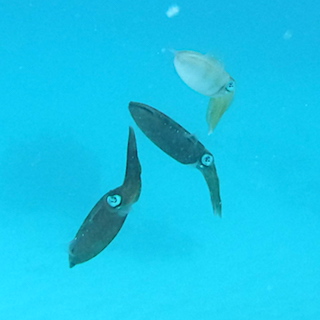
|

|
| A Southern Stingray feeding in Francis Bay | Elkhorn Coral and Common Sea Fans at Salt Pond Bay |
|---|---|
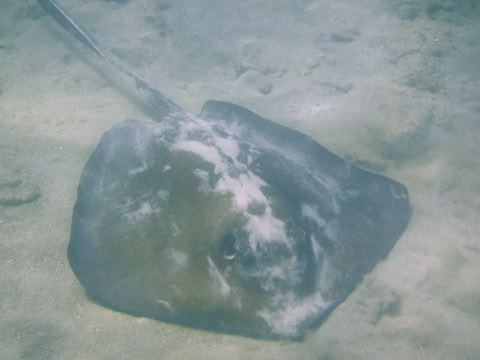
|
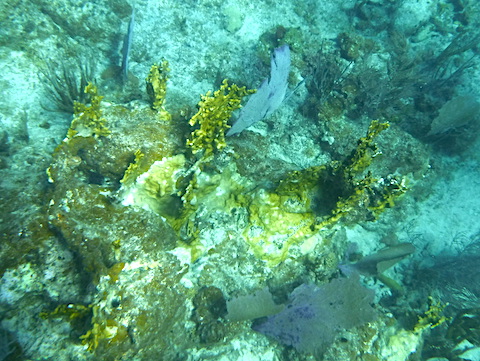
|
|
A Hawksbill Turtle with two Sharksuckers at Maho Bay. A third sharksucker is hiding under the turtle’s belly. |
Great Barracuda at Salt Pond Bay with its mouth held open to allow a cleaning goby to clean its teeth |
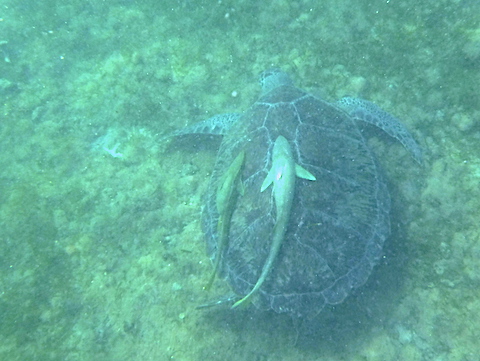
|
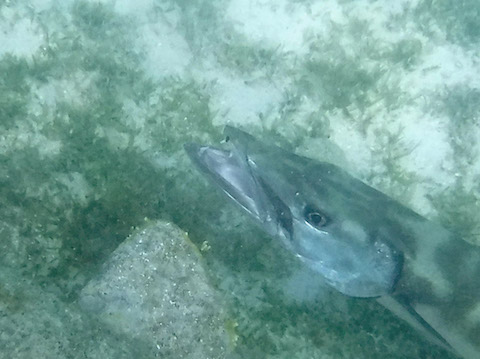
|
|
The Lionfish we found near Haulover Beach |
A Squirrelfish amidst French Grunts on a sunny day at Francis Bay |

|

|
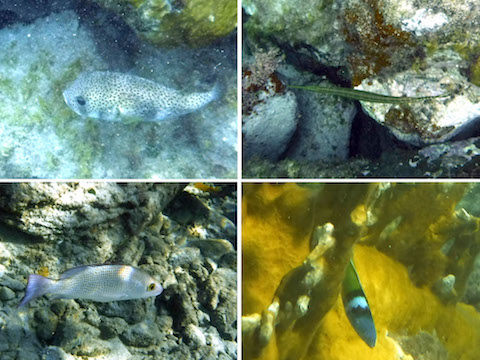
|
It is relaxing to drift along the shoreline of one of St. John’s bays,
watching the fish swimming below you.
You enjoy the swirling motions of the schools of small grunts.
You keep an eye open for unusual residents, the barracuda,
the porcupine fish, the squid, and others.
Occasionally you will see a fish that is new to you.
You rise and fall with the waves, and watch the seafans and sears waving below you.
Boulder and brain coral, sea urchins, anemones, and christmastree worms pass underneath.
Eventually you have to turn around and flipper back to the beach, and it feels good.
Getting into the water is the hardest part. The fins float so you have to hold onto both as you try to put the first on. Every wave that comes along threatens to wash them away. After you manage to get one fin on, the buoyancy of that fin threatens to upend you with every wave that rolls in while you struggle with the second one. I enjoy photographing what I see in the water. My last camera, a Canon D-10, died during our vacation in Bonaire, after it had been repaired or replaced several times in previous years. For this trip to St. John, I decided to buy a Fujifilm XP-120 because Gail had an XP-60 that had worked well for her for several years. My new camera worked well during six of our snorkeling excursions, but it died after about 30 minutes during our last snorkel of the vacation. I’m very happy it lasted almost to the end. It was still under warranty so, once we got back to Maryland, it went back to the manufacturer for repair or replacement. |
|
We stayed at Peaceful Cottage No. 1,
one of two cottages owned by Trevor, a transplanted South African.
Our cottage featured one large room with a small kitchen at one end, and a bed and closets
at the other. This was a step up from our beloved Maho Bay Campground because it had a bathroom,
so no climbing up dozens of Maho Bay’s stairs to reach the communal facilities, and the
shower had hot water! The tap water was from a cistern filled by rain from the
roof, so, for drinking, we used bottled water from the market.
Trevor’s Jack Russell terrier, Jackie, was always happy to see us, even though she was mostly blind, and she loved being pet. The cat, Ying Yang, also liked to be greeted, but she was a little more playful and would bring her claws out. In the evenings, the peeps of frogs provided a lullaby for sleep. In the morning, they were there again to wake us, along with the coos of the Zenaida Doves and, long before the sun came up, the advertisements by the free-range roosters. The cottage was located off Gift Hill Road, near its intersection with Centerline Road, so it was easy to get to any place on the island. In the Virgin Islands, both United States and British, we drive on the left. This makes for good practice for our planned stop in Scotland in June. We rarely found ourselves on the wrong side. Our vehicle was a Ford Escape from Courtesy Car Rental. It would have been better to have a vehicle with higher clearance. With the Escape, we often scraped bottom navigating onto Trevor’s driveway, and we were unable to visit Lameshur Bay and some other southside snorkeling areas. |
|
|
More living area on the cottage’s porch |
You could cook a meal here, but we sampled the restaurants |
|---|---|
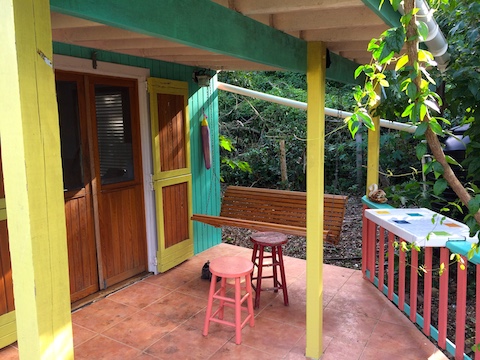
|
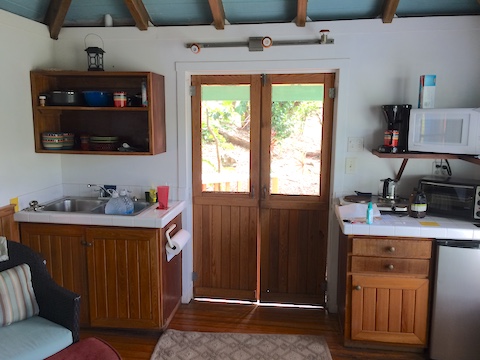
|
We ate at nine different restaurants during our visit, ranging from Extra Virgin Bistro and Rhumb Lines at the high end to an unnamed hole in the wall at the ferry terminal at Red Hook at the low end. In Coral Bay, on the east end of the island, we dined at Pickles in Paradise Deli and Skinny Legs. We would eat at almost all of them again, but the food at Extra Virgin Bistro and at the ferry terminal were special treats.
|
We did not see many birds.
On our second to last full day on the island, a Park Ranger told us
of a small flock of parrots that had taken up residence on Lind Point.
He thought they had been blown in from Puerto Rico by the hurricane.
The following afternoon we walked the Lind Point Trail all the way
to Honeymoon Beach, but did not see the parrots.
During our time on St. John, we enjoyed watching the Brown Boobies fish. We also saw an Ani, a Common Moorhen, Black-faced Grassquits, Brown Pelicans, small Egrets, and Common Ground-doves. Pearly-eyed Thrashers and Zenaida Doves were common.
Looking closely at the trees, you can see that, despite the greenery now, many have branches and the upper parts of trunks twisted off. Behind all the beautiful beaches lie tangles of downed trees. This land was subjected to a great deal of violence. Yet, the abundance of free-range chickens (gallus gallus domesticus) shows that many birds survived Irma. Maybe our lack of bird viewings was because we were usually in the water in the mornings when birds were more likely to be about. |

|
| Remains of the Archeology Lab at Cinnamon Bay | Damaged building in the center of Cruz Bay | |
|---|---|---|
| Have you ever had remodeling or repairs done to your house? Didn’t it take longer than you expected? Now imagine that one third of your neighbors needed all their windows replaced, a roof repaired, a missing roof replaced, a missing room or even a whole missing level rebuilt. Work would go slowly as you all competed for skilled workers and materials. That is how it is on St. John, only 4½ months after Irma came through. There are buildings in all stages of repair. There are piles of debris along the roads, still waiting to be carted to the big dump at the intersection of Gift Hill Road and Centerline Road. They start to bring things to the dump at 6 A.M. every day. Employees of BBC Electric from Missouri work 12-hour days, 7 days a week to install electrical power lines. |

|

|
|
Sunken and beached boats in Leinster Bay |
New Horizons yacht beached at Leinster Bay |
|

|

|
Not surprisingly, Irma was not friendly to boats. Our
host Trevor’s boat lost its mast when another
boat got loose and hit it. The mast was salvaged from the bottom
of the bay
while we were there. If it can’t be repaired, it might
cost as much as $80,000 to replace.
Beached and sunken boats can be see at many places. We saw five at Leinster Bay. At Princess Bay, there are about a dozen yachts piled on top one another at the head of bay and others sunken in the bay. Some of these boats can be salvaged, but every day others are loaded on barges to be taken to recycling centers. |
We returned home on a beautiful sunny Wednesday, January 31. We would have liked to stay longer, but our flight reservations came up and obligations at home called.
Responsible: Albert Holm
Created: 4 February 2018; Updated: 4 March 2018